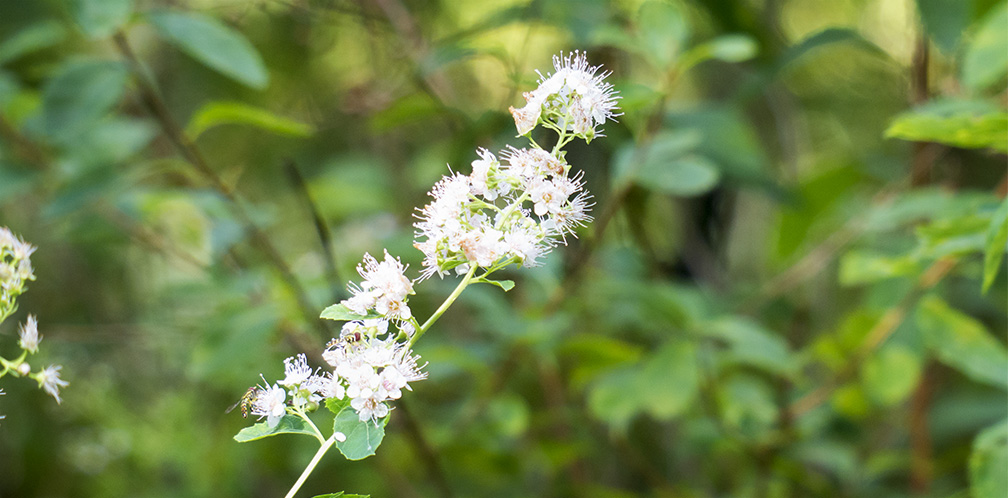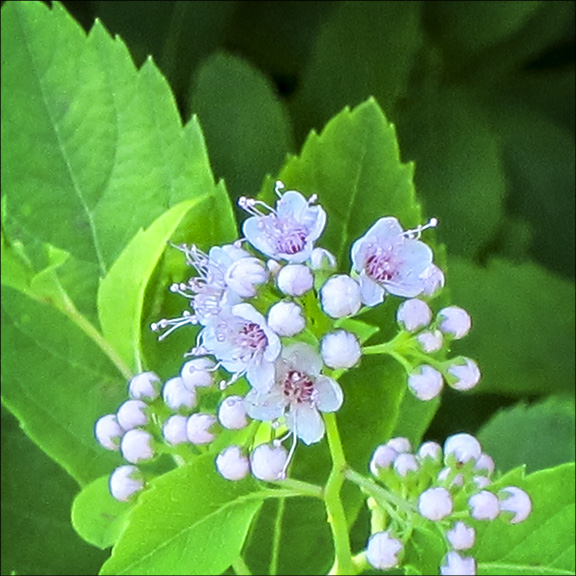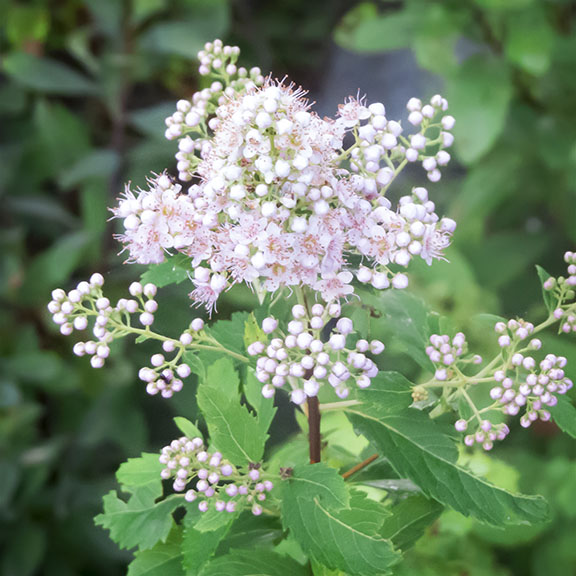Shrubs of the Adirondacks:
White Meadowsweet (Spiraea alba var. latifolia)

White Meadowsweet (Spiraea alba Du Roi var. latifolia (Aiton) Dippel) is a native Adirondack shrub that grows in old fields, meadows, swamps, and roadsides. It produces white or pale-pink flower clusters in summer. This shrub usually blooms in the Adirondack Park from July to mid-August.
White Meadowsweet is a member of the Rose family. The scientific name is often listed in field guides as Spiraea latifolia. This plant is also known as Meadowsweet, Meadow-sweet, Broad-leaved Meadowsweet, Meadowsweet Spiraea, and Northern White Meadowsweet. There are several contradictory theories as to why this plant and its very similar relative (Narrow-leaved Meadowsweet) were named Meadowsweet.
- One theory (suggested by John Eastman) is that the name did not originate from the word "meadow" at all, but from "mead-wort," once used to flavor home-brewed mead. This explanation may relate to another plant: Filipendula ulmaria. The latter is a herbaceous perennial shrub native to Europe also called Meadowsweet or Queen of the Meadow and used in the Middle Ages to make mead-wort (an alcoholic drink made by fermenting honey and fruit juices).
- Another theory (suggested by Donald Stokes) is that the name refers to the sweet smell of the blossoms and the plant's preference for moist, sunny places, such as old meadows.
Identification of White Meadowsweet

The flowers of White Meadowsweet are arrayed in an upright, loose flower cluster, usually three to five inches long. The individual flowers are white or pale pink, with five round petals, five sepals, and numerous pink-red stamens. In the Adirondacks, the White Meadowsweet flowers in July through about mid-August.
The leaves are simple and alternate, which means that they emerge from the stem one at a time, making the leaves appear to alternate on the stem. The leaves are two to four inches long. They are egg-shaped or broadly lance-shaped and are coarsely and unevenly toothed.
The twigs are smooth and reddish or purplish brown in color. The fruit consists of numerous dry capsules in upright clusters. The fruit matures in autumn.
White Meadowsweet can be distinguished from several similar species by leaf shape, twigs, and habitat.
- Narrow-leaved Meadowsweet (Spiraea alba Du Roi var. alba) is very similar in appearance to White Meadowsweet. Narrow-leaved Meadowsweet grows in similar habitats, but is less widespread in the Adirondack Park. It has narrower leaves, which have finely toothed edges, contrasting with the coarser teeth of the more abundant White Meadowsweet. Narrow-leaved Meadowsweet also has downy, yellowish stems.
- Steeplebush (Spiraea tomentosa), a shrub which is commonly found in the Adirondack Mountains, has pink to rose-purple flowers. Its flower clusters are narrower and tighter than those of the White Meadowsweet. In addition, the lower leaf surface on the Steeplebush is covered with dense woolly hairs. Steeplebush also has a more pronounced preference for wet soils, and is usually found in stream-side meadows, wet thickets, ditches, peatlands, swamps, and marshes.
Uses of White Meadowsweet
White Meadowsweet has limited uses as food and medicine. The Abnaki are said to have used the leaves to make tea. The Algonquin reportedly brewed a medicinal tea from the plant and used it as a medicinal tea. The Iroquois used a decoction of the plant with other leaves and branches for nausea and vomiting.
Wildlife Value of White Meadowsweet
White Meadowsweet's wildlife value is intermediate. Although it is not ranked as an important wildlife food, Meadowsweet twigs are eaten by Snowshoe Hares and White-tailed Deer. Cottontail Rabbits occasionally browse the lower leaves and twigs. Ruffed Grouse are said to consume the buds. Several bird species build their nests in Meadowsweet, including Northern Harrier, Alder Flycatcher, Indigo Bunting, Yellow Warbler, and Gray Catbird.
White Meadowsweet flowers provide nectar to the following butterflies:
Two-spotted Skipper (Euphyes bimacula)
White Admiral (Limenitis arthemis)
Striped Hairstreak (Satyrium liparops)
Edwards' Hairstreak (Satyrium edwardsii)
Acadian Hairstreak (Satyrium acadica)
Banded Hairstreak (Satyrium calanus)
Distribution of White Meadowsweet

White Meadowsweet is widely distributed in the eastern part of North America. It grows in the eastern provinces of Canada, including Quebec, Ontario, and Manitoba, and in the northeastern parts of the US, including New England and the mid-Atlantic states, as well as mid-Western states, such as Minnesota and Michigan.
Within New York State, White Meadowsweet is found in nearly all counties in the eastern two-thirds of the State. This plant is abundant in the Adirondacks. Vouchered plant specimens of White Meadowsweet have been documented in all counties within the Adirondack Park.
Habitat of White Meadowsweet
White Meadowsweet grows in a variety of habitats. You can find it growing on many sites with nearly full sun. Although this shrub seems to prefer moist soil, it can also be found in fairly well-drained soil. White Meadowsweet is particularly abundant in old fields and swamps, especially on old burned-over out-wash plains. It also grows under power lines, in early successional forests and wet thickets, and along roadsides and trails.
In old fields, such as those at John Brown Farm, look for White Meadowsweet growing near common wildflowers, such as milkweed and Queen Anne's Lace. At Heart Lake, you can find White Meadowsweet growing on the moist banks of the lake shore. In swampy areas, this plant can sometimes be found near its close relative, Steeplebush, and other shrubs that prefer wet soil, such as the Northern Wild Raisin.
References
Michael Kudish. Adirondack Upland Flora: An Ecological Perspective (Saranac, New York: The Chauncy Press, 1992), pp. 158-159.
Lawrence Newcomb. Newcomb's Wildflower Guide (Little Brown and Company, 1977), pp. 310-311.
John Kricher. A Field Guide to Eastern Forests. North America (Boston: Houghton Mifflin, 1998), pp. 166, 191, 198, 244-245.
William K. Chapman and Alan E. Bessette. Trees and Shrubs of the Adirondacks: A Field Guide (Utica, New York: North Country Books, 1990), p. 49, Plate 16.
Roger Tory Peterson and Margaret McKenny. A Field Guide to Wildflowers. Northeastern and North-central North America (Houghton Mifflin Company, 1968) pp. 284-285.
William K. Chapman, et al. Wildflowers of New York in Color (Syracuse University Press, 1998), pp. 12-13.
Anne McGrath. Wildflowers of the Adirondacks (EarthWords, 2000), p. 66, Plate 16.
Alexander C. Martin, Herbert S. Zim, and Arnold L. Nelson. A Guide to Wildlife Food Habits (New York: Dover Publications, 1951), pp. 268-269.
John Eastman. The Book of Swamp and Bog: Trees, Shrubs, and Wildflowers of Eastern Freshwater Wetlands (Stackpole Books, 1995), pp. 118-120.
William Carey Grimm. The Illustrated Book of Wildflowers and Shrubs (Stackpole Books, 1993), pp. 442-443.
Donald W. Stokes. The Natural History of Wild Shrubs and Vines (Harper & Row, 1981), pp. 78-83.
United States Department of Agriculture. Plants Database. Retrieved 8 February 2017.
New York Flora Association. New York Flora Atlas. Spiraea alba var. latifolia. Retrieved 8 February 2017.
Northern Forest Atlas. Images. Meadowsweet, Spiraea alba. Retrieved 8 February 2017.
Lady Bird Johnson Wildflower Center. Plant Database. Retrieved 8 February 2017.
New England Wildflower Society. White Meadowsweet. Spiraea alba Du Roi. Retrieved 8 February 2017.
Plants for a Future. Database. Retrieved 8 February 2017.
University of Michigan Herbarium. Spiraea alba Du Roi. Retrieved 8 February 2017.
Encyclopedia of Life. White Meadowsweet. Spiraea alba var. latifolia. Retrieved 8 February 2017.
University of Michigan. Native American Ethnobotany. A Database of Foods, Drugs, Dyes and Fibers of Native American Peoples, Derived from Plants. Spiraea alba var. latifolia (Ait.) Dippel. Retrieved 8 February 2017.
Birds of North America. Subscription Web Site. Northern Harrier, Alder Flycatcher, Indigo Bunting, Gray Catbird, Yellow Warbler. Retrieved 8 February 2017.
Butterflies and Moths of North America. Speyeria atlantis, Euphyes bimacula, Limenitis arthemis, Satyrium liparops, Satyrium edwardsii, Satyrium acadica, and Satyrium calanus. Retrieved 8 February 2017.
New York State Department of Environmental Conservation. New York Natural Heritage Program. Ecological Communities of New York State. Second Edition (March 2014), pp.48-50, 55-56, 59-60, 64, 66, 87, 102. Retrieved 8 February 2017.
New York Natural Heritage Program. 2021. Online Conservation Guide for Boreal Heath Barrens. Retrieved 24 July 2021.
New York Natural Heritage Program. 2021. Online Conservation Guide for Shrub Swamp. Retrieved 24 July 2021.
